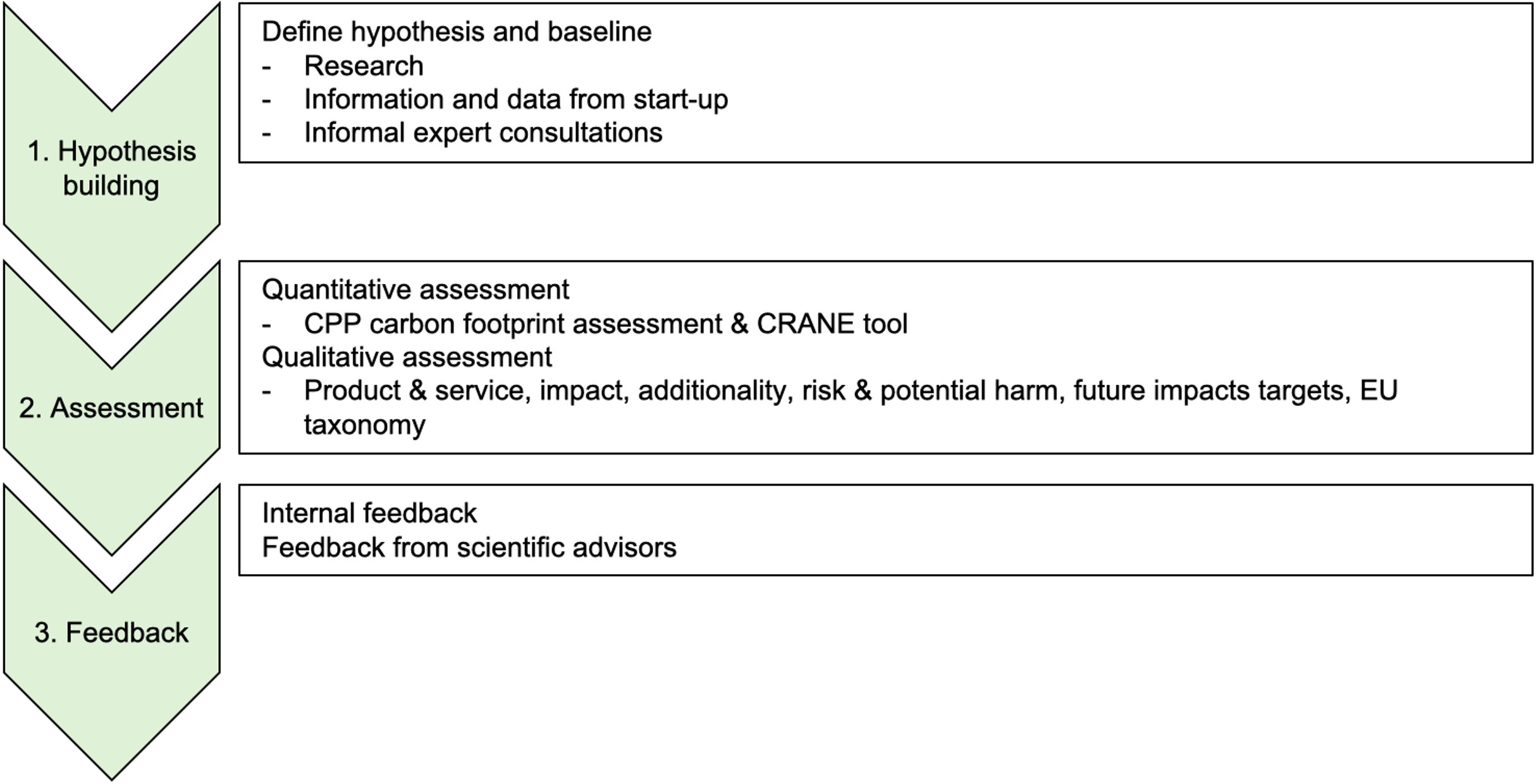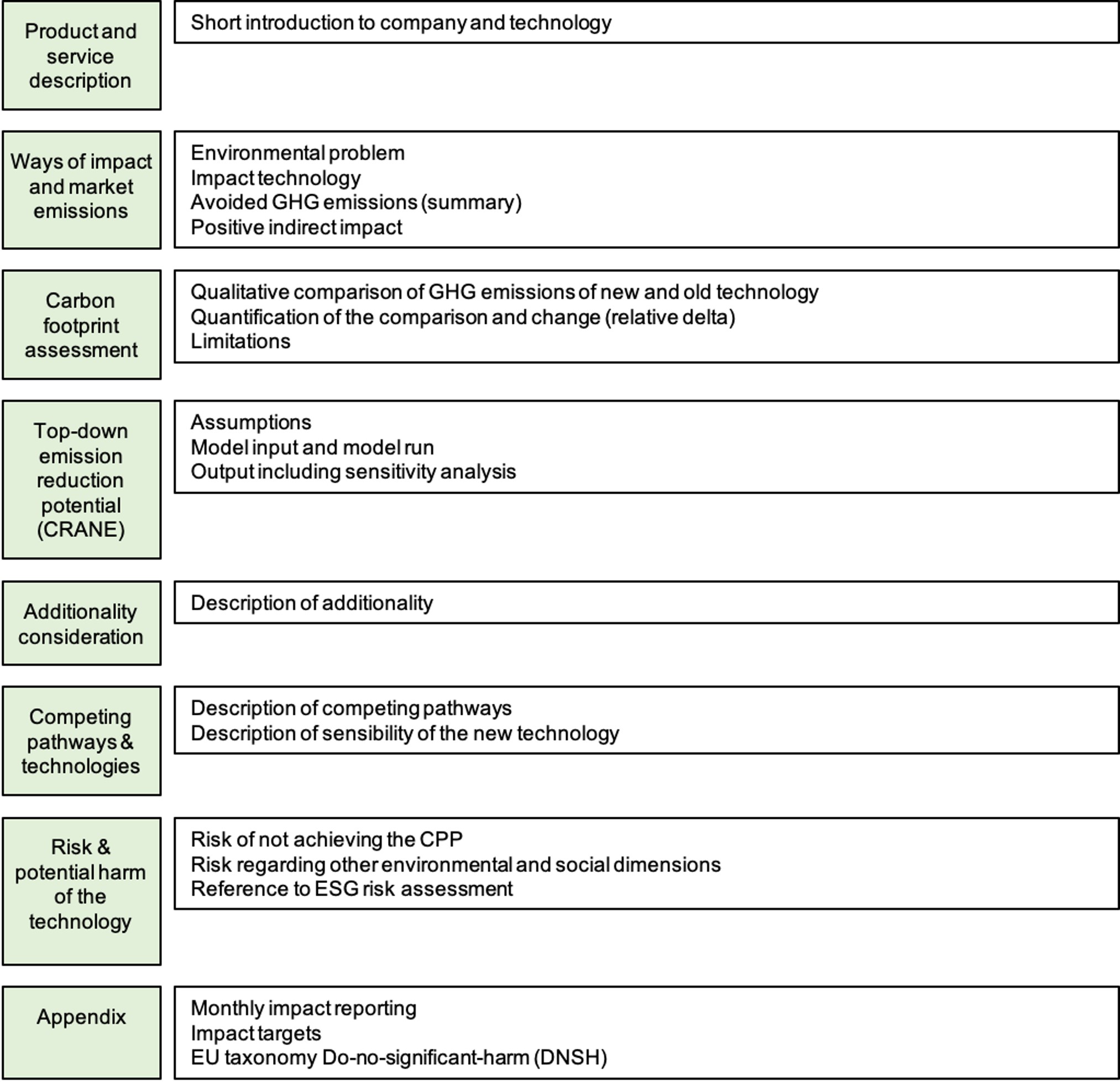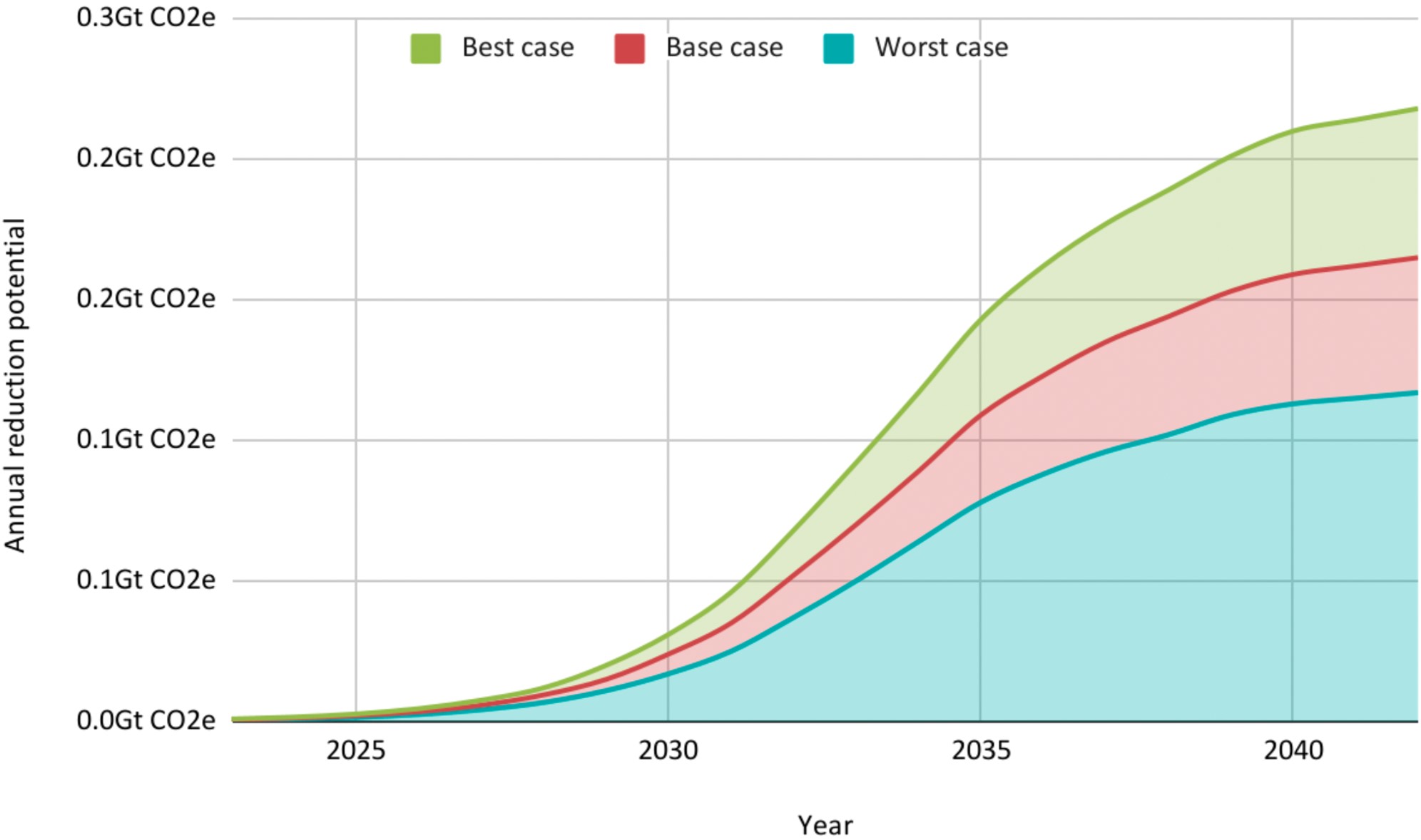Article Peer-Reviewed
Assessing the Climate Performance Potential of Start-ups: Insights and Guidance on Environmental Sustainability Assessment of Young Ventures
Chair of Sustainable Engineering, Institute of Environmental Technology, Technische Universität Berlin, 10623 Berlin, Germany
*
For correspondence.
Academic Editor:
Received: 20 June 2023 Accepted: 4 October 2023 Published: 6 October 2023
This article is part of the Special Issue Capturing the Sustainable Impact of Early-Stage Business Models.
Abstract
The role of early-stage venture capital (VC) investment in financing for ambitious climate action is often overlooked. In the developing field of climate-tech investment, one of the biggest challenges is to identify the start-ups and business models that contribute to climate change mitigation. The potential of a start-ups business model to reduce greenhouse gas emissions is defined as the start-ups climate performance potential (CPP). The assessment of a start-up’s CPP could enable start-ups and VC investors to invest in a more informed way with greater precision, impact, and purpose. The objective of this paper can be expressed in two steps: First, to gain insights into and identify the potential for improvement in the environmental sustainability assessment practices of VC firms through an exploratory case study. Second, to provide life cycle-based guidance on environmental sustainability assessment of innovative products offered by start-ups to determine their CPP, by eliciting appropriate criteria and procedures for directionally sound assessment. For this, the assessment approach developed by the climate-tech VC firm World Fund was used for the exploratory case study. In a first step, the CPP assessment process was described, based on document review and observation. Next, the CPP carbon footprint method was compared with ISO standardizations of life cycle assessment (LCA) and carbon footprint (CF) along eight criteria. Development potential was identified and discussed for seven of the eight criteria, including, for example, the use of scenarios, the complexity of meta-analyses, and the need to avoid misleading incentives.
Figures in this Article
Keywords
sustainable entrepreneurship; start-up; venture capital investment; climate-tech investment; start-up sustainability assessment; climate performance potential; life cycle assessment
Copyright © 2023
Diekel et al. This article is distributed under the terms of the Creative Commons Attribution License (CC BY 4.0), which permits unrestricted use and distribution provided that the original work is properly cited.
Supplementary Material
Supplementary Material
(PDF, 39.5 MB)
Cite this Article
Diekel, F., Bach, V., & Finkbeiner, M. (2023). Assessing the Climate Performance Potential of Start-ups: Insights and Guidance on Environmental Sustainability Assessment of Young Ventures. Highlights of Sustainability, 2(4), 207–223. https://doi.org/10.54175/hsustain2040015
References
1.
Shukla, P. R., Skea, J., Slade, R., Al Khourdajie, A., van Diemen, R., McCollum, D., et al. (Eds.). (2022). IPCC Climate Change 2022: Mitigation of Climate Change (Contribution of Working Group III to the Sixth Assessment Report of the Intergovernmental Panel on Climate Change). Cambridge University Press.
2.
Louche, C., Busch, T., Crifo, P., & Marcus, A. (2019). Financial Markets and the Transition to a Low-Carbon Economy: Challenging the Dominant Logics. Organization & Environment, 32(1), 3–17. https://doi.org/10.1177/1086026619831516
3.
Bergset, L. (2015). The Rationality and Irrationality of Financing Green Start-Ups. Administrative Sciences, 5(4), 260–285. https://doi.org/10.3390/admsci5040260
4.
Bergset, L. (2017). Green Start-up Finance – Where Do Particular Challenges Lie? International Journal of Entrepreneurial Behavior & Research, 24(2), 451–575. https://doi.org/10.1108/IJEBR-11-2015-0260
5.
PricewaterhouseCoopers LLP. (2021). State of Climate Tech 2021. Scaling breakthroughs for net zero. State of Climate Tech. https://www.pwc.com/gx/en/services/sustainability/publications/state-of-climate-tech.html (accessed 27 February 2023).
6.
Hegeman, P. D., & Sørheim, R. (2021). Why Do They Do It? Corporate Venture Capital Investments in Cleantech Startups. Journal of Cleaner Production, 294, 126315. https://doi.org/10.1016/j.jclepro.2021.126315
7.
Lin, L. (2022). Venture Capital in the Rise of Sustainable Investment. European Business Organization Law Review, 23(1), 187–216. https://doi.org/10.1007/s40804-021-00238-8
8.
Anand, A., Argade, P., Barkemeyer, R., & Salignac, F. (2021). Trends and Patterns in Sustainable Entrepreneurship Research: A Bibliometric Review and Research Agenda. Journal of Business Venturing, 36(3), 106092. https://doi.org/10.1016/j.jbusvent.2021.106092
9.
Horne, J., & Fichter, K. (2022). Growing for Sustainability: Enablers for the Growth of Impact Startups – A Conceptual Framework, Taxonomy, and Systematic Literature Review. Journal of Cleaner Production, 349, 131163. https://doi.org/10.1016/j.jclepro.2022.131163
10.
Leendertse, J., van Rijnsoever, F. J., & Eveleens, C. P. (2021). The Sustainable Start-up Paradox: Predicting the Business and Climate Performance of Start-Ups. Business Strategy and the Environment, 30(2), 1019–1036. https://doi.org/10.1002/bse.2667
11.
Trautwein, C. (2021). Sustainability Impact Assessment of Start-Ups – Key Insights on Relevant Assessment Challenges and Approaches Based on an Inclusive, Systematic Literature Review. Journal of Cleaner Production, 281, 125330. https://doi.org/10.1016/j.jclepro.2020.125330
12.
Finkbeiner, M., Schau, E. M., Lehmann, A., & Traverso, M. (2010). Towards Life Cycle Sustainability Assessment. Sustainability, 2(10), 3309–3322. https://doi.org/10.3390/su2103309
13.
Ness, B., Urbel-Piirsalu, E., Anderberg, S., & Olsson, L. (2007). Categorising Tools for Sustainability Assessment. Ecological Economics, 60(3), 498–508. https://doi.org/10.1016/j.ecolecon.2006.07.023
14.
Sala, S. (2020). Chapter 3 - Triple Bottom Line, Sustainability and Sustainability Assessment, an Overview. In J. Ren, A. Scipioni, A. Manzardo, & H. Liang (Eds.), Biofuels for a More Sustainable Future (pp. 47–72). Elsevier. https://doi.org/10.1016/B978-0-12-815581-3.00003-8
15.
International Organization for Standardization. (2006). Environmental management—Life cycle assessment—Principles and framework (ISO 14040:2006).
16.
International Organization for Standardization. (2006). Environmental management—Life cycle assessment—Requirements and guidelines (ISO 14044:2006).
17.
International Organization for Standardization. (2018). Greenhouse Gases — Carbon Footprint of Products — Requirements and Guidelines for Quantification (ISO 14067:2018).
18.
Bhatia, P., Cummis, C., Brown, A., Draucker, L., Rich, D., & Lahd, H. (2011). Product Life Cycle Accounting and Reporting Standard. World Business Council for Sustainable Development and World Resource Institute.
19.
Das, A., Konietzko, J., & Bocken, N. (2022). How Do Companies Measure and Forecast Environmental Impacts When Experimenting with Circular Business Models? Sustainable Production and Consumption, 29, 273–285. https://doi.org/10.1016/j.spc.2021.10.009
20.
DIN. (2020). DIN SPEC 90051-1:2020-11. Specification for sustainability assessment of start-ups Part 1: Concept and criteria for the assessment of potential and actual impact of venture projects and young enterprises on the environment, society and economy. Beuth. https://doi.org/10.31030/3204886
21.
Horne, J., Recker, M., Michelfelder, I., Jay, J., & Kratzer, J. (2020). Exploring Entrepreneurship Related to the Sustainable Development Goals - Mapping New Venture Activities with Semi-Automated Content Analysis. Journal of Cleaner Production, 242, 118052. https://doi.org/10.1016/j.jclepro.2019.118052
22.
Buure, K. (2022). Startup Sustainability: Creating a Sustainability Assessment Tool for Startup Businesses [Master’s Thesis, Lappeenranta-Lahti University of Technology LUT]. LUTPub. https://urn.fi/URN:NBN:fi-fe2022080452738
23.
Halberstadt, J., & Johnson, M. (10–12 September 2014). Sustainability Management for Startups and Micro-Enterprises: Development of a Sustainability-Quick-Check and Reporting Scheme. International Conference on Informatics for Environmental Protection, Oldenburg, Germany.
24.
Horne, J. (2019). The Sustainability Impact of New Ventures: Measuring and Managing Entrepreneurial Contributions to Sustainable Development [PhD Thesis, Technische Universität Berlin]. DepositOnce. https://doi.org/10.14279/depositonce-8420
25.
Judl, J., Mattila, T., Manninen, K., & Antikainen, R. (2015). Life Cycle Assessment and Ecodesign in a Day - Lessons Learned from a Series of LCA Clinics for Start-Ups and Small and Medium Enterprises (SMEs). Finnish Environment Institute.
26.
Kraaij, A., & Poldner, K. (14 June 2021). BM Experimentation; A Tool for Calculating the Financial and Sustainable Business Case of New Business Models. The 6th International Conference on New Business Models, Halmstad, Sweden.
27.
Lingane, A., & Olsen, S. (2004). Guidelines for Social Return on Investment. California Management Review, 46(3), 116–135. https://doi.org/10.2307/41166224
28.
Obst, L. (2015). Utilizing the Business Model Canvas to Enable Sustainability Measurement on the Business Model Level: An Indicator Framework Supplementing the Business Model Canvas [Master’s Thesis, University of Twente]. University of Twente Theses. https://purl.utwente.nl/essays/68263
29.
Varga, D. (2018). Triple-Bottom-Line Impact Analysis Framework of Fintech Companies. Vezetéstudomány - Budapest Management Review, 49(11), 24–34. https://doi.org/10.14267/VEZTUD.2018.11.03
30.
Burger, S. P., Systrom, N., & Kearney, S. (2017). Climate Impact Assessment for Early-Stage Ventures. PRIME Coalition and New York State Energy Research and Development Authority (NYSERDA). https://www.primecoalition.org/library/climate-impact-assessment-for-early-stage-ventures (accessed 20 December 2022).
31.
CRANE. (2022). Resources. https://cranetool.org/resources (accessed 22 December 2022).
32.
ImpactNexus. (2023). ImpactNexus - Solutions - for Startups. https://impactnexus.io/solutions-startups#ghg-impact-estimator-tool (accessed 5 September 2023).
33.
World Fund. (2022). https://www.worldfund.vc (accessed 8 June 2022).
34.
Bergset, L., & Fichter, K. (2015). Green Start-Ups – a New Typology for Sustainable Entrepreneurship and Innovation Research. Journal of Innovation Management, 3, 118–144. https://doi.org/10.24840/2183-0606_003.003_0009
35.
Bocken, N. M. P. (2015). Sustainable Venture Capital – Catalyst for Sustainable Start-up Success? Journal of Cleaner Production, 108, 647–658. https://doi.org/10.1016/j.jclepro.2015.05.079
36.
Botelho, T., Mason, C., & Chalvatzis, K. (2022). 50 Shades of Green—Angel Investing in Green Businesses. IEEE Transactions on Engineering Management, 70(3), 950–962. https://doi.org/10.1109/TEM.2022.3167282
37.
Gaddy, B. E., Sivaram, V., Jones, T. B., & Wayman, L. (2017). Venture Capital and Cleantech: The Wrong Model for Energy Innovation. Energy Policy, 102, 385–395. https://doi.org/10.1016/j.enpol.2016.12.035
38.
Jensen, F., Lööf, H., & Stephan, A. (2020). New Ventures in Cleantech: Opportunities, Capabilities and Innovation Outcomes. Business Strategy and the Environment, 29(3), 902–917. https://doi.org/10.1002/bse.2406
39.
Marcus, A., Malen, J., & Ellis, S. (2013). The Promise and Pitfalls of Venture Capital as an Asset Class for Clean Energy Investment: Research Questions for Organization and Natural Environment Scholars. Organization & Environment, 26(1), 31–60. https://doi.org/10.1177/1086026612474956
40.
Owen, R., Brennan, G., Lyon, F., & Harrer, T. (2021). Financing Cleantech SME Innovation: Setting an Agenda. IEEE Transactions on Engineering Management, 68(4), 1168–1172. https://doi.org/10.1109/TEM.2020.3005702
41.
Edmondson, A. C., Mcmanus, S. E. (2007). Methodological Fit in Management Field Research. Academy of Management Review, 32(4), 1246–1264. https://doi.org/10.5465/amr.2007.26586086
42.
Cassell, C., Symon, G., Buehring, A., & Johnson, P. (2006). The Role and Status of Qualitative Methods in Management Research: An Empirical Account. Management Decision, 44(2), 290–303. https://doi.org/10.1108/00251740610650256
43.
Eisenhardt, K. M. (2021). What Is the Eisenhardt Method, Really? Strategic Organization, 19(1), 147–160. https://doi.org/10.1177/1476127020982866
44.
Eisenhardt, K. M., & Graebner, M. E. (2007). Theory Building from Cases: Opportunities and Challenges. The Academy of Management Journal, 50(1), 25–32. https://doi.org/10.5465/amj.2007.24160888
45.
Gaya, H. J., & Smith, E. E. (2016). Developing a Qualitative Single Case Study in the Strategic Management Realm: An Appropriate Research Design? International Journal of Business Management & Economic Research, 7(2), 529–538.
46.
Gibbert, M., Ruigrok, W., & Wicki, B. (2008). What Passes as a Rigorous Case Study? Strategic Management Journal, 29(13), 1465–1474. https://doi.org/10.1002/smj.722
47.
Lee, B., Collier, P. M., & Cullen, J. (2007). Reflections on the Use of Case Studies in the Accounting, Management and Organizational Disciplines. Qualitative Research in Organizations and Management: An International Journal, 2(3), 169–178. https://doi.org/10.1108/17465640710835337
48.
Mariotto, F. L., Zanni, P. P., & Moraes, G. H. S. M. D. (2014). What is the use of single-case study in management research? Revista de Administração de Empresas, 54(4), 358–369. https://doi.org/10.1590/S0034-759020140402
49.
Siggelkow, N. (2007). Persuasion With Case Studies. Academy of Management Journal, 50(1), 20–24. https://doi.org/10.5465/amj.2007.24160882
50.
World Fund. (2021). Climate Impact Assessment QOA.
51.
World Fund. (2021). Climate Impact Assessment Juicy Marbles.
52.
World Fund. (2021). Investment Process [Presentation].
53.
World Fund. (2021). Impact and ESG Practices throughout the Investment Process [Presentation].
54.
World Fund. (2021). Deal Identification [Presentation].
55.
Hancock, D. R., & Algozzine, R. (2006). Doing Case Study Research: A Practical Guide for Beginning Researchers. Teachers College Press.
56.
Bjørn, A., Owsianiak, M., Molin, C., & Hauschild, M. Z. (2018). LCA History. In M. Z. Hauschild, R. K. Rosenbaum, & S. I. Olsen (Eds.), Life Cycle Assessment: Theory and Practice (pp. 17–30). Springer. https://doi.org/10.1007/978-3-319-56475-3_3
57.
Arendt, R., Bach, V., & Finkbeiner, M. (2021). Carbon Offsets: An LCA Perspective. In S. Albrecht, M. Fischer, P. Leistner, & L. Schebek (Eds.), Progress in Life Cycle Assessment 2019 (pp. 189–212). Springer. https://doi.org/10.1007/978-3-030-50519-6_14
58.
World Fund. (2021). Press Release World Fund Launch.
59.
Keane, J. (7 December 2022). Climate VC World Fund Secures €50 Million From European Investment Fund. Forbes. https://www.forbes.com/sites/jonathankeane/2022/12/07/climate-vc-world-fund-secures-50-million-from-european-investment-fund (accessed 18 December 2022).
60.
Višević, D., & Valenzuela, D. (2021). How to Measure the Climate Performance Potential of Startups. Medium. https://visevic.medium.com/how-to-measure-the-climate-performance-potential-of-startups-6cc7fdb4110f (accessed 8 June 2022).
61.
Heller, M. C., & Keoleian, G. A. (2018). Beyond Meat’s Beyond Burger Life Cycle Assessment: A Detailed Comparison Between comparison between a plant-based and an animal-based protein source. University of Michigan.
62.
Khan, S., Dettling, J., Hester, J., & Moses, R. (2019). Comparative Environmental LCA of the Impossible Burger with Conventional Ground Beef Burger, Final Report. Impossible Foods.
63.
Saerens, W., Smetana, S., Van Campenhout, L., Lammers, V., & Heinz, V. (2021). Life Cycle Assessment of Burger Patties Produced with Extruded Meat Substitutes. Journal of Cleaner Production, 306, 127177. https://doi.org/10.1016/j.jclepro.2021.127177
64.
Saget, S., Porto Costa, M., Santos, C. S., Vasconcelos, M., Styles, D., & Williams, M. (2021). Comparative Life Cycle Assessment of Plant and Beef-Based Patties, Including Carbon Opportunity Costs. Sustainable Production and Consumption, 28, 936–952. https://doi.org/10.1016/j.spc.2021.07.017
65.
Saget, S., Costa, M., Santos, C. S., Vasconcelos, M. W., Gibbons, J., Styles, D., et al. (2021). Substitution of Beef with Pea Protein Reduces the Environmental Footprint of Meat Balls Whilst Supporting Health and Climate Stabilisation Goals. Journal of Cleaner Production, 297, 126447. https://doi.org/10.1016/j.jclepro.2021.126447
66.
Poore, J., & Nemecek, T. (2018). Reducing Food’s Environmental Impacts through Producers and Consumers. Science, 360(6392), 987–992. https://doi.org/10.1126/science.aaq0216
67.
Clausen, J., & Fichter, K. (2019). The diffusion of environmental product and service innovations: Driving and inhibiting factors. Environmental Innovation and Societal Transitions, 31, 64–95. https://doi.org/10.1016/j.eist.2019.01.003
68.
Thonemann, N., Schulte, A., & Maga, D. (2020). How to Conduct Prospective Life Cycle Assessment for Emerging Technologies? A Systematic Review and Methodological Guidance. Sustainability, 12(3), 1192. https://doi.org/10.3390/su12031192
69.
Bisinella, V., Christensen, T. H., & Astrup, T. F. (2021). Future Scenarios and Life Cycle Assessment: Systematic Review and Recommendations. The International Journal of Life Cycle Assessment, 26(11), 2143–2170. https://doi.org/10.1007/s11367-021-01954-6
70.
Joyce, P. J., & Björklund, A. (2022). Futura: A New Tool for Transparent and Shareable Scenario Analysis in Prospective Life Cycle Assessment. Journal of Industrial Ecology, 26(1), 134–144. https://doi.org/10.1111/jiec.13115
71.
Steubing, B., & de Koning, D. (2021). Making the Use of Scenarios in LCA Easier: The Superstructure Approach. The International Journal of Life Cycle Assessment, 26(11), 2248–2262. https://doi.org/10.1007/s11367-021-01974-2
72.
Thonemann, N., Zacharopoulos, L., Fromme, F., & Nühlen, J. (2022). Environmental Impacts of Carbon Capture and Utilization by Mineral Carbonation: A Systematic Literature Review and Meta Life Cycle Assessment. Journal of Cleaner Production, 332, 130067. https://doi.org/10.1016/j.jclepro.2021.130067
73.
Adrianto, L. R., van der Hulst, M. K., Tokaya, J. P., Arvidsson, R., Blanco, C. F., Caldeira, C., et al. (2020). How Can LCA Include Prospective Elements to Assess Emerging Technologies and System Transitions? The International Journal of Life Cycle Assessment, 26(8), 1541–1544. https://doi.org/10.1007/s11367-021-01934-w
74.
O’Neill, B. C., Kriegler, E., Riahi, K., Ebi, K. L., Hallegatte, S., Carter, T. R., et al. (2014). A New Scenario Framework for Climate Change Research: The Concept of Shared Socioeconomic Pathways. Climatic Change, 122(3), 387–400. https://doi.org/10.1007/s10584-013-0905-2
75.
Pintér, L., Hardi, P., Martinuzzi, A., Hall, J. (2012). Bellagio STAMP: Principles for Sustainability Assessment and Measurement. Ecological Indicators, 17, 20–28. https://doi.org/10.1016/j.ecolind.2011.07.001
76.
Janeway, W. H., Nanda, R., & Rhodes-Kropf, M. (2021). Venture Capital Booms and Start-Up Financing. Annual Review of Financial Economics, 13(1), 111–127. https://doi.org/10.1146/annurev-financial-010621-115801
77.
Rin, M. D., Hellmann, T., & Puri, M. (2013). Chapter 8 - A Survey of Venture Capital Research. In G. M. Constantinides, M. Harris, & R. M. Stulz (Eds.), Handbook of the Economics of Finance (Vol. 2, pp. 573–648). Elsevier. https://doi.org/10.1016/B978-0-44-453594-8.00008-2
78.
Padey, P., Blanc, I., Le Boulch, D., & Xiusheng, Z. (2012). A Simplified Life Cycle Approach for Assessing Greenhouse Gas Emissions of Wind Electricity. Journal of Industrial Ecology, 16(s1), S28–S38. https://doi.org/10.1111/j.1530-9290.2012.00466.x
79.
Brandão, M., Heath, G., & Cooper, J. (2012). What Can Meta-Analyses Tell Us About the Reliability of Life Cycle Assessment for Decision Support? Journal of Industrial Ecology, 16, S3–S7. https://doi.org/10.1111/j.1530-9290.2012.00477.x
80.
Price, L., & Kendall, A. (2012). Wind Power as a Case Study. Journal of Industrial Ecology, 16(s1), S22–S27. https://doi.org/10.1111/j.1530-9290.2011.00458.x
81.
Zumsteg, J. M., Cooper, J. S., & Noon, M. S. (2012). Systematic Review Checklist: A Standardized Technique for Assessing and Reporting Reviews of Life Cycle Assessment Data. Journal of Industrial Ecology, 16(s1), S12–S21. https://doi.org/10.1111/j.1530-9290.2012.00476.x
82.
Manfredi, S., Allacker, K., Chomkhamsri, K., Pelletier, N., & de Souza, D. M. (2012). Product Environmental Footprint (PEF) Guide. European Commission (EC) Joint Research Center (JRC). https://lirias.kuleuven.be/1924754?limo=0 (accessed 5 October 2023).
Metrics
Loading...
Journal Menu
Journal Contact
Highlights of Sustainability
Editorial Office
Highlights of Science
Avenida Madrid, 189-195, 3-3
08014 Barcelona, Spain
08014 Barcelona, Spain
Cathy Wang
Managing Editor



